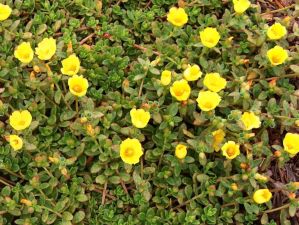Portulaca oleracea (common purslane, also known as
verdolaga,
pigweed,
little hogweed, or
pursley, and moss rose) is an annual succulent in the family Portulacaceae, which may reach 40 cm in height.
Purslane, raw
Nutritional value per 100 g (3.5 oz), Energy 84 kJ (20 kcal), Carbohydrates 3.39 g, Fat 0.36 g, Protein 2.03 g, Water 92.86 g, Vitamin A 1320 IU, Thiamine (vit. B1) 0.047 mg (4%)Riboflavin (vit. B2) 0.112 mg (9%), Niacin (vit. B3) 0.48 mg (3%), Vitamin B6 0.073 mg (6%), Folate (vit. B9) 12 µg (3%), Vitamin C 21 mg (25%), Vitamin E 12.2 mg (81%)Calcium 65 mg (7%), Iron 1.99 mg (15%), Magnesium 68 mg (19%), Manganese 0.303 mg (14%), Phosphorus 44 mg (6%), Potassium 494 mg (11%), Zinc 0.17 mg (2%)Percentages are roughly approximated
It has smooth, reddish, mostly prostrate stems and alternate leaves clustered at stem joints and ends. The yellow flowers have five regular parts and are up to 6 mm wide. Depending upon rainfall, the flowers appear at anytime during the year. The flowers open singly at the center of the leaf cluster for only a few hours on sunny mornings. Seeds are formed in a tiny pod, which opens when the seeds are mature. Purslane has a taproot with fibrous secondary roots and is able to tolerate poor, compacted soils and drought.


Health Benefits of verdolaga:
This wonderful green leafy vegetable is very low in calories (just 16 kcal/100g) and fats; nonetheless, it is rich in dietary fiber, vitamins, and minerals.
Fresh leaves contain surprisingly more omega-3 fatty acids (a-linolenic acid) than any other leafy vegetable plant. 100 grams of fresh purslane leaves provide about 350 mg of a-linolenic acid. Research studies show that consumption of foods rich in ?-3 fatty acids may reduce the risk of coronary heart disease, stroke, and help prevent the development of ADHD, autism, and other developmental differences in children.
It is an excellent source of Vitamin A, (1320 IU/100 g, provides 44% of RDA) one of the highest among green leafy vegetables. Vitamin A is a known powerful natural antioxidant and is essential for vision. This vitamin is also required to maintain healthy mucus membranes and skin. Consumption of natural vegetables and fruits rich in vitamin A is known to help to protect from lung and oral cavity cancers.
Purslane is also a rich source of vitamin C, and some B-complex vitamins like riboflavin, niacin, pyridoxine and carotenoids, as well as dietary minerals, such as iron, magnesium, calcium, potassium, and manganese.
Furthermore, present in purslane are two types of betalain alkaloid pigments, the reddish beta-cyanins and the yellow beta-xanthins. Both pigment types are potent anti-oxidants and have been found to have anti-mutagenic properties in laboratory studies
Read More at Wikipedia

